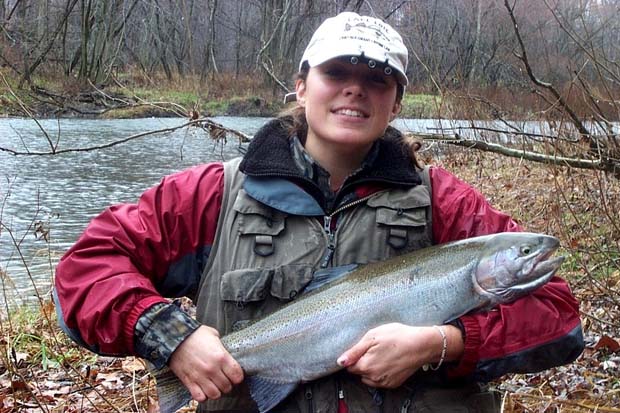[dropcap]T[/dropcap]he outlying states of the Great Lakes sustain a $7,000,000,000 fishing industry by producing salmonoids through fish hatcheries that enter the system – joining generations of naturally reproducing brethren. All of these fish, whether they were born in a hatchery or matured in a tributary, are genetically programmed to return to their birth grounds and reproduce. The Chambers Creek and Skamania strains of steelhead will migrate in the early spring through the summer months from the deep offshore waters, but the majority of the salmonoids will make the journey during the fall months. Most notably and in this chronological order; the Chinook salmon, coho salmon, brown trout, and steelhead (taxonomically exactly the same as a rainbow trout). All of the latter species capable of reaching 15-pounds and more than a few outliers reaching better than 20-pounds.
When these fish return to the shorelines and tributaries to perform their biological duty of passing on their genetics an angler on foot has more than a fair shot at landing a trophy fish. In the Great Lakes (Michigan, Superior, Huron, Erie and Ontario), this nation’s and Canada’s best fresh water fisheries, bulge with salmons, trouts, perch, bass and walleye that hurry to bulk up for the long, cold winter and to do their spawning thing.
If you live near one of the Great Lakes and have an affection for fly fishing action, this is time to go for steelies and salmons. It’s heating up now up and will stay hot into November and throughout the winter in some fisheries so don’t put the tools away in the basement just yet.
Great Lakes Flow
Lake Superior via St. Mary’s River into Lake Huron > Lake Huron via St. Clair River into Lake St. Clair > Lake St. Clair via Detroit River into Lake Erie > Lake Erie via Niagara River (Niagara Falls) into Lake Ontario (Welland Canal circumvents Niagara Falls). Lake Ontario via St. Lawrence River into the Atlantic Ocean.
Great Lakes Fly Patterns
Steelhead
Egg patterns (small size #8 to #14) assorted colors; Glo Bug; Sucker Spawn; Crystal Meth; Nymph patterns (size #6 to #14);
Hare’s Ear; Pheasant Tail; Prince Nymph; Streamer patterns (size #4 to #12); Egg Sucking Leech; Wooly Bugger and Marabou
Spey.
Universal Great Lakes Patterns
Black Stoneflies; Green Caddis; Egg flies (moe egg & glo bug style); Egg-sucking Leech; Marabou Speys; Woolly Buggers; Simple hair-wings like a Skunk; Hex Nymphs, Hare’s Ear Nymphs (large sizes) and Pheasant Tail Nymphs.
Techniques
Traditional indicator
90 degree rigs
Tight-line nymphing
Swinging flies (Spey or switch rods)
[information]
Contacts:
http://www.michigan.gov/dnr
http://www.fish.state.pa.us/
http://www.dec.ny.gov/about/564.html
http://ohiodnr.com/Home/tabid/4414/Default.aspx
http://www.in.gov/dnr/fishwild/
http://www.michigan.gov/dnr
http://www.dnr.illinois.gov/Pages/default.aspx
http://dnr.wi.gov/
[/information]






